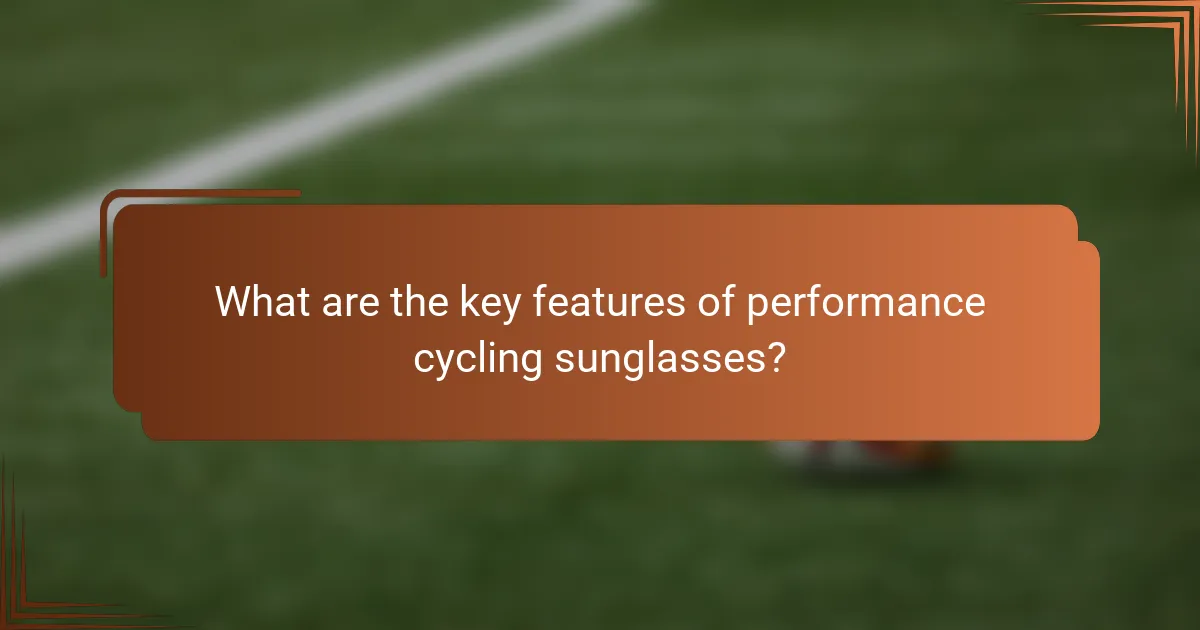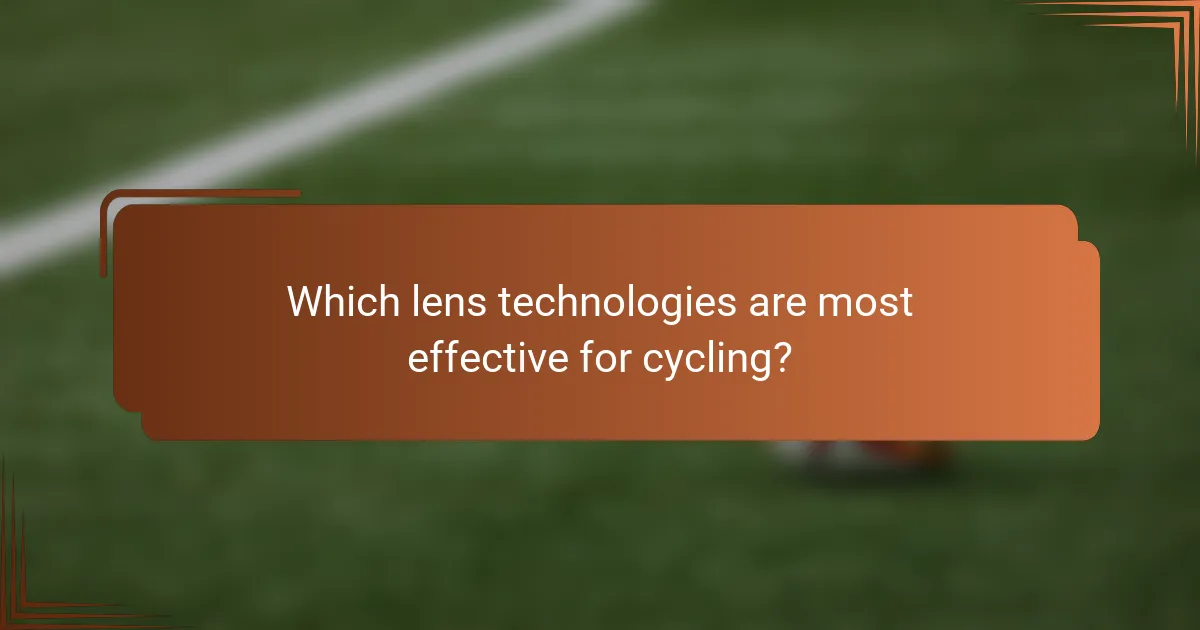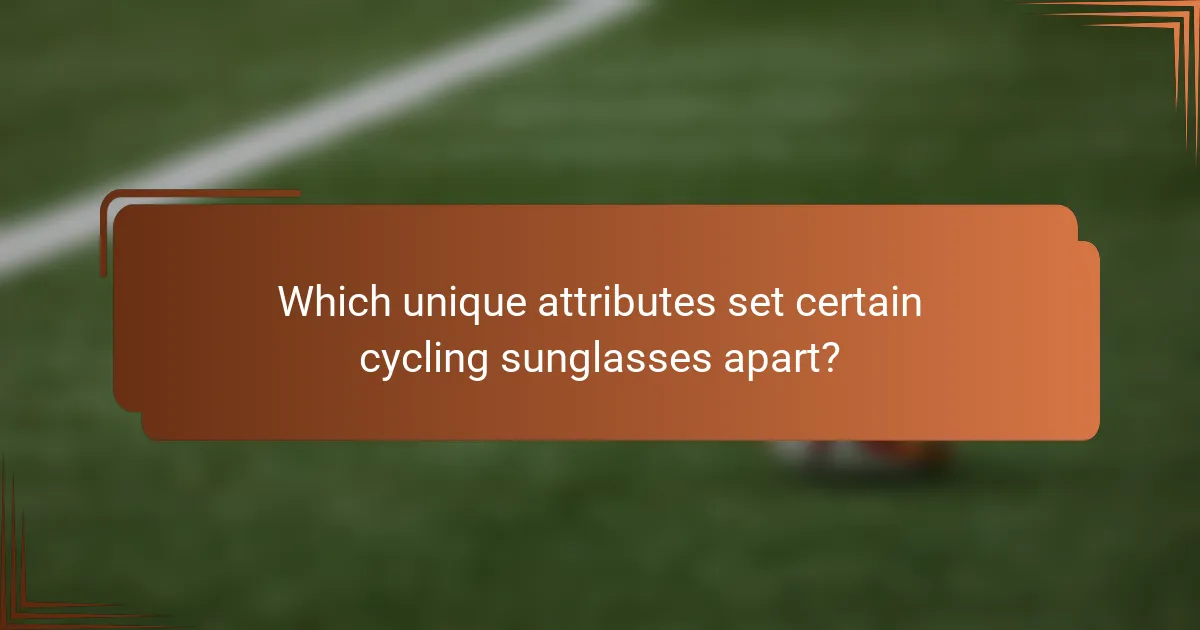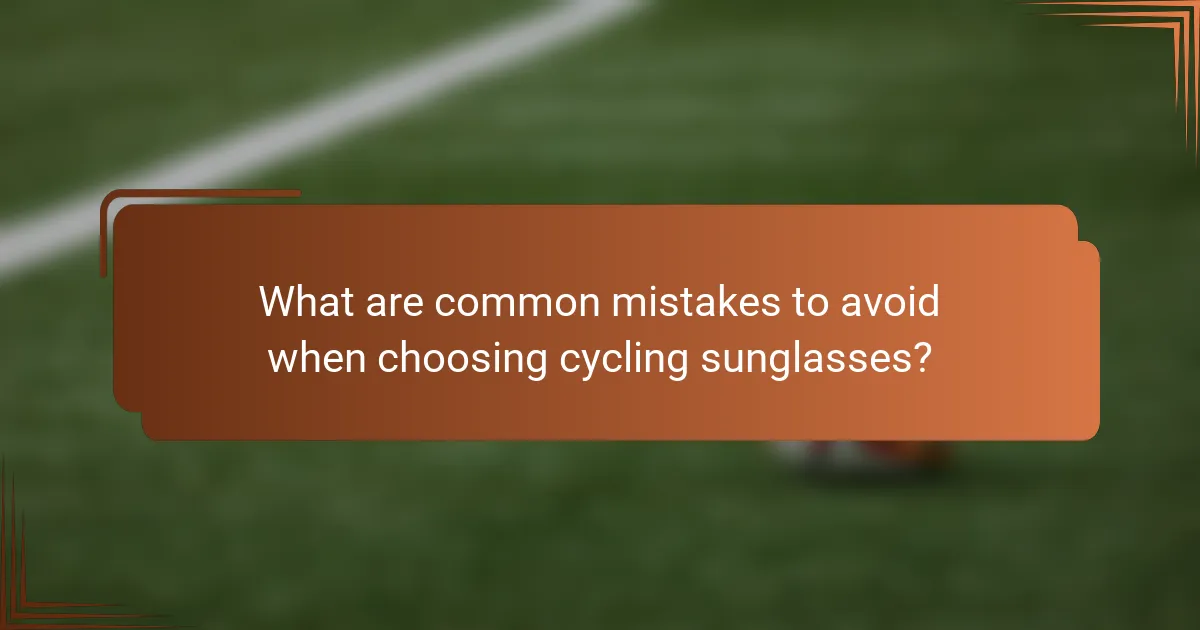Choosing the right performance cycling sunglasses can significantly enhance your ride by improving visibility and comfort. This article explores advanced lens technology, essential UV protection, and the importance of a comfort fit. Discover how features like photochromic lenses and ergonomic designs contribute to a better cycling experience. Learn to avoid common mistakes when selecting sunglasses for optimal performance and safety on the road.

What are the key features of performance cycling sunglasses?
Performance cycling sunglasses feature advanced lens technology, UV protection, and a comfort fit. These attributes enhance visibility and safety during rides.
1. Lens Technology: High-quality lenses offer clarity and distortion-free vision. Many sunglasses use photochromic or polarized lenses to adapt to changing light conditions.
2. UV Protection: Effective sunglasses block 100% of UVA and UVB rays, protecting the eyes from harmful sun exposure.
3. Comfort Fit: Ergonomically designed frames ensure a secure fit, reducing slippage and discomfort during long rides.
4. Ventilation: Many models incorporate ventilation systems to minimize fogging, maintaining clear vision in varying temperatures.
5. Lightweight Materials: Performance sunglasses often use lightweight materials like polycarbonate, ensuring durability without adding bulk.
How does lens technology enhance cycling performance?
Lens technology enhances cycling performance by improving visibility, reducing glare, and offering UV protection. High-quality lenses can adapt to varying light conditions, ensuring optimal clarity and focus. The right lens tint can enhance contrast, helping cyclists spot obstacles and changes in terrain more effectively. Additionally, lightweight and comfortable frames ensure a secure fit, allowing cyclists to maintain focus on their ride without distractions. Overall, advanced lens technology is crucial for maximizing cycling efficiency and safety.
Why is UV protection crucial for cyclists?
UV protection is crucial for cyclists to shield against harmful sun rays. Prolonged exposure can lead to eye damage, including cataracts and macular degeneration. Performance cycling sunglasses with advanced lens technology provide essential UV filtering, enhancing visual clarity and comfort. Additionally, a comfortable fit ensures that cyclists can maintain focus on the road, reducing distractions. Investing in quality sunglasses is vital for long-term eye health and optimal cycling performance.
What are the comfort fit considerations for long rides?
Comfort fit considerations for long rides include proper lens coverage, lightweight frames, and adjustable features. These elements enhance stability and reduce pressure points during extended wear. High-quality materials improve comfort by minimizing irritation and ensuring a secure fit. Additionally, ventilation systems in sunglasses can prevent fogging, maintaining clear vision throughout the ride.

Which lens technologies are most effective for cycling?
Performance cycling sunglasses with advanced lens technologies, such as photochromic and polarized lenses, are most effective for cycling. These technologies enhance visibility and reduce glare, improving overall performance. Photochromic lenses adjust to varying light conditions, providing optimal UV protection. Polarized lenses minimize glare from surfaces, enhancing clarity. Comfort fit is essential, ensuring stability during rides while maintaining airflow to prevent fogging.
How do polarized lenses improve visibility?
Polarized lenses enhance visibility by reducing glare from reflective surfaces, such as water or pavement. This technology improves clarity and contrast, allowing cyclists to see obstacles and changes in terrain more effectively. As a result, performance cycling sunglasses with polarized lenses can significantly enhance safety and comfort during rides.
What role do photochromic lenses play in varying light conditions?
Photochromic lenses adapt to changing light conditions, enhancing visibility and comfort for cyclists. They darken in bright sunlight and lighten in low light, providing optimal eye protection. This technology reduces glare and improves contrast, crucial for performance cycling. Additionally, photochromic lenses filter harmful UV rays, ensuring long-term eye health during outdoor activities.
Which lens tints are best for different cycling environments?
Different cycling environments require specific lens tints for optimal performance. For bright, sunny conditions, dark tints like grey or brown enhance contrast and reduce glare. In low-light or overcast situations, yellow or amber tints improve visibility and depth perception. For varied terrains, photochromic lenses adapt to changing light conditions, providing versatility. Clear lenses are ideal for night riding, ensuring maximum visibility without tint interference.

How does UV protection vary across different brands?
UV protection varies significantly across different brands of performance cycling sunglasses. Factors such as lens technology, coatings, and UV rating determine the effectiveness of UV protection.
| Brand | UV Protection Level | Lens Technology | Additional Features |
|——————–|———————|————————-|——————————–|
| Brand A | UV400 | Polarized | Anti-fog coating |
| Brand B | UV380 | Photochromic | Lightweight frame |
| Brand C | UV400 | Mirrored | Scratch-resistant coating |
| Brand D | UV500 | Polycarbonate | Adjustable nose pads |
| Brand E | UV400 | High-definition | Ventilated design |
What are the standards for UV protection in sunglasses?
Sunglasses should block 100% of UVA and UVB rays to meet UV protection standards. High-quality performance cycling sunglasses typically feature lenses that provide optimal protection while enhancing visibility. Look for lenses with a UV400 rating, indicating they filter out wavelengths up to 400 nanometers. This ensures comprehensive protection against harmful solar radiation. Additionally, polarization can reduce glare, improving comfort and safety during rides.
Which brands are known for superior UV protection?
Brands known for superior UV protection in performance cycling sunglasses include Oakley, Smith, Rudy Project, Tifosi, and Nike. These brands utilize advanced lens technologies that effectively block harmful UV rays while ensuring clarity and comfort. Oakley’s Prizm lens technology enhances contrast and visibility, while Smith’s ChromaPop lenses provide vibrant colour and detail. Rudy Project emphasizes lightweight designs with high UV protection, and Tifosi offers affordable options without compromising on quality. Nike combines style with performance, catering to various cyclist needs.

What factors contribute to a comfortable fit in cycling sunglasses?
Several factors contribute to a comfortable fit in cycling sunglasses. Key elements include frame material, adjustable nose pads, temple length, and lens curvature.
Lightweight materials reduce pressure on the face, enhancing comfort during long rides. Adjustable nose pads allow for a personalized fit, accommodating various face shapes. The appropriate temple length ensures stability without pinching the head. Lastly, lens curvature improves aerodynamics and reduces wind exposure, further enhancing comfort.
How do frame materials affect comfort during rides?
Frame materials significantly impact comfort during rides by influencing weight, flexibility, and fit. Lightweight materials like carbon fibre enhance comfort by reducing strain on the nose and ears. Flexible frames adapt better to facial contours, providing a secure fit that minimizes pressure points. For example, rubberized components improve grip and prevent slippage, further enhancing comfort during movement. Overall, choosing the right frame material is crucial for optimal comfort in performance cycling sunglasses.
What adjustments can be made for a personalized fit?
To achieve a personalized fit with performance cycling sunglasses, consider adjustable nose pads and temple arms. These features allow for a customized fit that enhances comfort and stability during rides. Additionally, selecting lightweight materials can improve overall wearability. Proper lens tinting can also enhance visibility based on weather conditions, ensuring optimal performance.

Which unique attributes set certain cycling sunglasses apart?
Unique attributes that set certain cycling sunglasses apart include advanced lens technology, superior UV protection, and an ergonomic comfort fit. These features enhance visibility, shield eyes from harmful rays, and ensure a secure fit during rides. Some sunglasses incorporate photochromic lenses, which adapt to changing light conditions, offering versatility. Additionally, anti-fog coatings and lightweight materials improve performance and user experience, making them ideal for serious cyclists.
What innovative features are emerging in 2025 models?
Emerging 2025 models of performance cycling sunglasses feature advanced lens technology, enhanced UV protection, and improved comfort fit. These innovations include photochromic lenses that adapt to light conditions, anti-fog coatings for better visibility, and ergonomic designs that enhance airflow. Additionally, some models incorporate smart technology for real-time performance tracking, providing cyclists with valuable feedback during rides.
How do certain brands incorporate advanced anti-fog technology?
Certain brands incorporate advanced anti-fog technology by utilizing specialized coatings and ventilation systems. These features enhance clarity and maintain visibility in various weather conditions. For example, brands like Oakley and Smith Sports Optics employ hydrophobic coatings that repel moisture and prevent fogging. Additionally, some models include adjustable vents that allow airflow, further reducing fog accumulation. This technology significantly improves the performance of cycling sunglasses, ensuring a comfortable fit and optimal vision during rides.

What are common mistakes to avoid when choosing cycling sunglasses?
Common mistakes when choosing cycling sunglasses include neglecting lens technology, overlooking UV protection, and prioritising style over comfort fit. Selecting lenses that enhance visibility and reduce glare is crucial for performance. Ensure the sunglasses provide 100% UV protection to safeguard your eyes during long rides. Additionally, a comfortable fit is essential to avoid distractions and ensure optimal performance.
How can cyclists ensure they select the right lens for their needs?
Cyclists can ensure they select the right lens by considering their specific riding conditions and personal preferences. Key factors include lens colour, which affects contrast and visibility, and UV protection level, essential for eye safety. Additionally, cyclists should evaluate the lens material for durability and scratch resistance. Comfort fit is crucial; frames should provide stability without pressure points. Lastly, interchangeable lenses offer versatility for varying light conditions.
What are the signs of poor fit and how can they be addressed?
Signs of poor fit in performance cycling sunglasses include discomfort, slipping during rides, and inadequate UV protection. These issues can be addressed by selecting frames with adjustable features, ensuring proper lens size, and prioritising models with superior grip technology.
Which maintenance practices prolong the life of cycling sunglasses?
Regular maintenance practices can significantly extend the lifespan of cycling sunglasses. Clean lenses with a microfiber cloth to avoid scratches. Store them in a protective case when not in use to prevent damage. Avoid exposing them to extreme temperatures, which can warp frames. Use lens cleaners designed for sports eyewear to maintain clarity and UV protection.